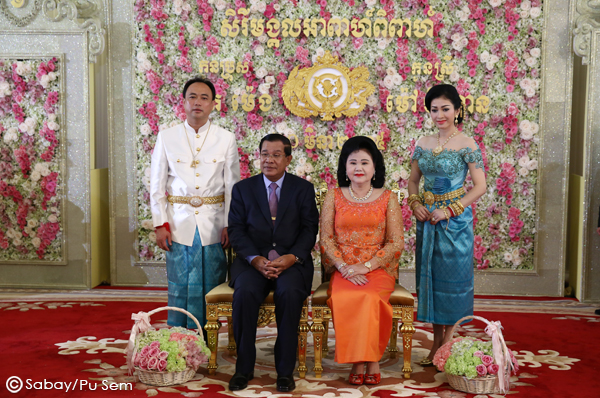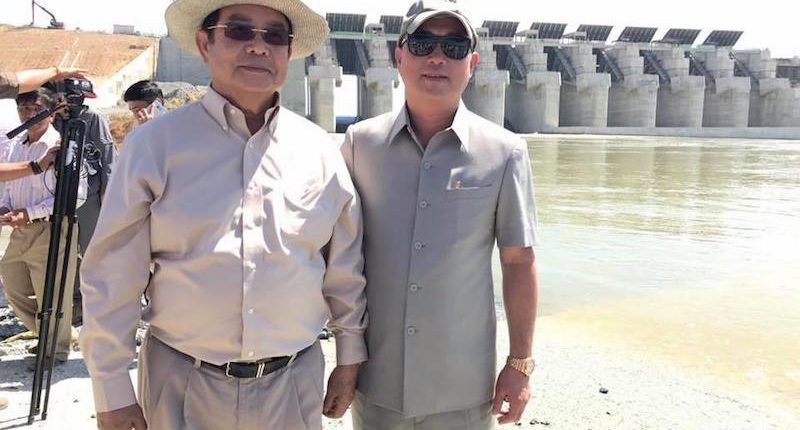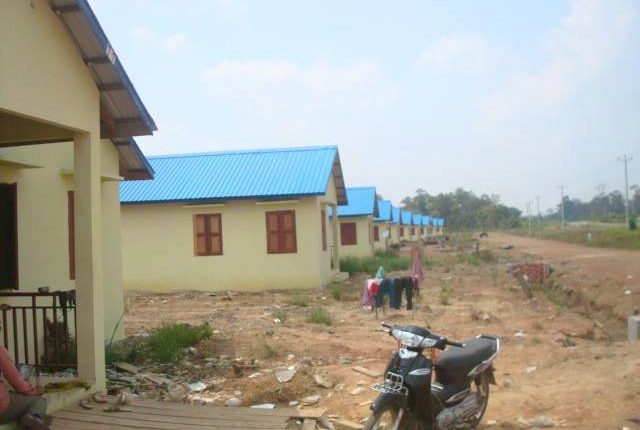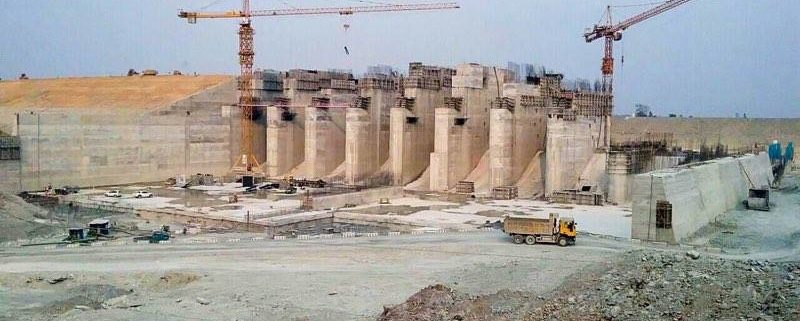Cambodian Mekong Dams -The Elite & Trade Agreements vs. The Poor

Kith Meng & Hun Sen at his wedding on 20-03-2015 – via news.sabay.com.kh

Kith Meng, right, poses with Mines and Energy Minister Suy Sem -in front of Lower Sesan II Dam in Stung Treng province – via The Cambodia Daily
For his lack of Social and Environmental responsibility and self-serving modus operandi, we have dubbed Kith Meng: “Cambodia’s Traitor‘.
This financial partnership further raises the question about the ethics of allowing Cambodian and Chinese conglomerates to build THREE Mega-Dams and thereby, make fundamental Social and Environmental decisions that will irreversibly affect the Mekong River ecosystem, its fisheries and its communities for all time, and increase Climate Warming. Particularly, when such decisions will most likely be biased towards protecting their own investments, i.e. a conflict of interests.
1) #Coal deals for Australia with @TurnbullMalcolm.
2) #Hydropower deals for @HunSenCambodia with #China
3) Ties in nicely the China and Australia Free Trade Agreement (CHaAFTA)
4) As Chairman of the ANZ Royal Group – Meng peddles multi-billion dollar investments in #Dams for ANZ Bank (Australia & New Zealand Bank). Yet, Australia’s ANZ claims that it has no deals with ANZ Royal Group… This is difficult to comprehend given that the Royal Group owns 40% of ANZ!
“Australia’s Mekong Water Resources Program will continue to help develop and better manage the region’s water resources for greater economic opportunities as well as to protect the 60 million people ... [ED. False!] … that rely directly on the Mekong River for their livelihoods. Hydropower development is vital for the economic future of countries of the Mekong Basin, and its transparent management is critical to the stability of countries and regional links. Through targeted investments in quality planning, our program is helping countries of the region build hydropower dams sustainably.”
Such a statement is the epitome of double-standards and falsehood! Australia’s interest in the Mekong region is clearly one of “Trade Agreements” = where to get profits!–The very principle of Dams as walls that block a river is “unsustainable” per se.
“In ecology, sustainability (from sustain and ability) is the property of biological systems to remain diverse and productive indefinitely. Long-lived and healthy wetlands and forests are examples of sustainable biological systems. In more general terms, sustainability is the endurance of systems and processes. The organizing principle for sustainability is sustainable development, which includes the four interconnected domains: ecology, economics, politics and culture.” (Wikipedia)
Moreover, studies on the economic trade-offs between the economic benefits of Hydropower development in the LMB and the irreversible negative impacts on the food supply and livelihoods of millions of poor people, have found that:
“there could be a reversal of the Net Present Value (NPV) estimates of the scenarios from a positive $33 billion to negative $274 billion.”

Relocation scheme village for displaced communities by the Lower Sesan2 Dam in the Srepok River, Cambodia
The Chinese plan for the Mekong Region was recently stated as: “Communities in the Mekong will stop “subsistence living” and will enter a “market-life”…
“It is not nations that are the winners or losers in the hydropower schemes in the Mekong, but rather parts of the riparian population: a few influential and powerful elites versus the large mass of rural poor.–
Examining hydropower development within the Mekong Basin reveals an obvious conflict interest between the needs of upstream and downstream countries, and especially between the priorities of Mekong upper class decision makers directly or indirectly profiting from the dams and the majority of the rural poor, whose livelihood they put at risk.
“NTPC, the World Bank, and the GoL have failed to conduct the type of assessment or mitigation and compensation measures that would appear to have been appropriate in the XBF River Basin for ethnic Brou people, and particularly Brou women, who should have been recognized as Indigenous Peoples.
Our study reveals that NT2 has transformed the XBF River in ways which negatively impact many local communities but especially the Indigenous Brou.
The NTPC and GoL have expressed the belief that NT2 would help alleviate poverty in rural communities of Laos, including by leaving project-affected people no worse off than before the project. However, while many factors impact local economies and livelihoods, Brou voices in the XBF Basin indicate that poverty clearly remains and, in affected areas, has been exacerbated by NT2, especially for women. Equitable distribution of development opportunities was supposed to be generated by NTPC, and have been promoted by the World Bank, but these have not effectively improved the livelihoods of most affected people.
Thus, this article suggests that we must reflect on the extent to which large-scale hydropower development is really a means for eradicating poverty for Indigenous Peoples and other marginalized groups. Are mitigation measures practically sound or are they just the rhetoric of project proponents? Governments and donors alike need to have a better understanding of the importance of the natural resource base to local and traditional livelihoods and the great difficulty, if not the impossibility, of successfully mitigating the impacts of huge infrastructure projects like NT2.”
–
At the core,it is all simply about ‘Trade Agreements’ – no matter the cost!We call this situation the ECOCIDE of the Mekong.It’s Criminal, Unethical, Immoral!
“Does Cambodia and the world really want to have to deal with a Humanitarian crisis the likes of which has never been seen in a relatively small area, with 40+ million hungry and desperate people in Cambodia alone?”
Citations
Coal outgrows hydropower. The Phnom Penh Post, Oct. 11, 2016. http://www.phnompenhpost.com/business/coal-outgrows-hydropower
–
Hun Sen attends Kith Meng’s marriage. March, 20, 2015. news.sabay.com.kh/article/312384
–
Kith Meng Backs Plans for Three Hydropower Dams.https://www.cambodiadaily.com/morenews/kith-meng-backs-plans-for-three-hydropower-dams-124528/ The Cambodia Daily, Fe. 3, 2017.
–
New era of big dam building on the Mekong? ABC Radio National Breakfast, Feb. 20, 2017. http://www.abc.net.au/radionational/programs/breakfast/new-era-of-big-dam-building-on-the-mekong/8285288
–
http://www.ifc.org/wps/wcm/connect/lao_ext_content/sustainable_hydropower/sustainability_hydropower/news/chinese+banks+can+play+key+role+in+shaping+sustainable+hydropower+development
Toll bails on rail, citing revenue. The Phnom Penh Post, Dec. 22, 2014. http://www.phnompenhpost.com/business/toll-bails-rail-citing-revenue
–
Final Report – Study on the Impacts of Mainstream Hydropower on the Mekong River – Impact Assessment Report. – Report prepared by Malmgren-Hansen, A. (DHI), Anwar Khan (HDR) & Kim Wium Olesen (DHI) for the Ministry of Natural Resources and Environment, Vietnam (VNMC) – January 18, 2016.
In: Comments on: Final Report – Study on the Impacts of Mainstream Hydropower Dams on the Mekong River – Impact Assessment Report. L. Corredor – on behalf of Scientists for the Mekong- January, 26, 2016.
https://scientists4mekong.com/2016/01/26/study-on-the-impacts-of-mainstream-hydropower-on-the-mekong-river-iar/
–
Royal Group submits plan for coal-fired plant. The Phnom Penh Post, September 8, 2016. http://www.phnompenhpost.com/business/royal-group-submits-plan-coal-fired-plant
–
http://www.eastasiaforum.org/2014/08/09/cambodias-ls2-dam-is-a-disaster-in-the-making/
–
Gov’t halts building of Koh Rong island port. The Phnom Penh Post. June 15, 2016.
http://www.phnompenhpost.com/national/govt-halts-building-koh-rong-island-porthttp://www.phnompenhpost.com/business/royal-groups-sihanoukville-port-be-razed
–
Corredor, L. (2015). COP21 – Mekong Dolphin Extinction, Hydropower & Climate Change – 2 December 2015 http://mahb.stanford.edu/library-item/cop21-dolphin-extinction-hydropower-climate-change/
–
Corredor, L. (2015). LIST of Damages by Hydropower Dams on the Mekong Basin. Scientists for the Mekong.
https://www.scientists4mekong.com/list-of-damages-by-hydropower-dams-in-the-mekong-basin/
–
Chinese Developer Signs $1.5 Billion MoU with Royal Group. Khmer Times, Nov. 19, 2015. http://www.khmertimeskh.com/news/17986/chinese-developer-signs–1-5-billion-mou-with-royal-group/
–
Nguyen V.M., Nguyen V.D., Nguyen N.H., M. Kummu, B. Merz & H. Apel (2015). Future sediment dynamics in the Mekong Delta floodplains: Impacts of hydropower development, climate change and sea level rise. Global and Planetary Change 127 (2015) 22–33 – 13 Jan. 2015 http://www.sciencedirect.com/science/journal/09218181
Download here: https://www.academia.edu/20957409/Future_sediment_dynamics_in_the_Mekong_Delta_floodplains_Impacts_of_hydropower_development_climate_change_and_sea_level_rise
–
Kingsford, R.T. (2000). Ecological impacts of Dams, water diversions and river management on floodplain Wetlands in Australia. Austral Ecology, April 2000, Volume 25, Issue 2, Pages 109–127 http://onlinelibrary.wiley.com/doi/10.1046/j.1442-9993.2000.01036.x/abstract;jsessionid=51AC1EC6A5CB25BA59D622ED5A02207D.f03t03
–
DFAT – Australia’s Mekong Water Resources Program – 19 April
http://dfat.gov.au/geo/east-asia/development-assistance/Pages/enabling-regional-economic-cooperation-south-east-asia-region.aspx
–
http://dfat.gov.au/geo/east-asia/development-assistance/Pages/enabling-regional-economic-cooperation-south-east-asia-region.aspx
https://www.academia.edu/3174505/Hydropower_development_in_the_lower_Mekong_basin_alternative_approaches_to_deal_with_uncertainty
Independent Analysis of the Mekong Delta Study (MDS) Impact Assessment Report – Prepared for Oxfam Mekong Regional Program, by Dr. Sokhem Pech, Chheng Phen, & Tes Sopharith, Version 1, Nov 28, 2015.
In: Comments on: Draft – Study on the Impacts of Mainstream Hydropower Dams on the Mekong River (MDS), Impact Assessment Report – L. Corredor on behalf of Scientists for the Mekong – December 17, 2015.
https://scientists4mekong.com/blogs/iar-impacts-of-hydropower-on-mekong-river/
Download here: https://www.academia.edu/30734681/The_World_Bank_Hydropower-based_Poverty_Alleviation_and_Indigenous_Peoples_On-the-_Ground_Realities_in_the_Xe_Bang_Fai_River_Basin_of_Laos
Baird, I.G. et al. (2015). The People and their River, the World Bank and its Dam: Revisiting the Xe Bang Fai River in Laos. Development and Change 46(5): 1080–1105. Published on behalf of International Institute of Social Studies, The Hague. – 3 Sept 2015
http://onlinelibrary.wiley.com/doi/10.1111/dech.12186/abstract
–
Baird, I.G & N. Quastel (2015). Rescaling and Reordering Nature–Society Relations: The Nam Theun 2 Hydropower Dam
and Laos–Thailand Electricity Networks. Annals of the Association of American Geographers, DOI: 10.1080/00045608.2015.1064511.
Link to this article: http://dx.doi.org/10.1080/00045608.2015.1064511
–
Green, W.N. & I.G. Baird (2015). Hydropower Compensation and Changing Nature-Society Relations in Laos – Search: Articles In: E- International Relations – 13 Jul 2015
http://www.e-ir.info/2015/07/13/hydropower-compensation-and-changing-nature-society-relations-in-laos/
–
Deemer, B.R. et al. (2016). Greenhouse Gas Emissions from Reservoir Water Surfaces: A New Global Synthesis. BioScience 2016; 66 (11): 949-964. doi: 10.1093/biosci/biw117.
Download here: https://academic.oup.com/bioscience/article/66/11/949/2754271/Greenhouse-Gas-Emissions-from-Reservoir-Water#“Given
–
Scientists have just detected a major change to the Earth’s oceans linked to a Warming Climate. The Washington Post, Feb. 15, 2017 .
https://www.washingtonpost.com/news/energy-environment/wp/2017/02/15/its-official-the-oceans-are-losing-oxygen-posing-growing-threats-to-marine-life/?utm_campaign=buffer&utm_content=buffer76727&utm_medium=social&utm_source=twitter.com&utm_term=.910e7456b5a0



